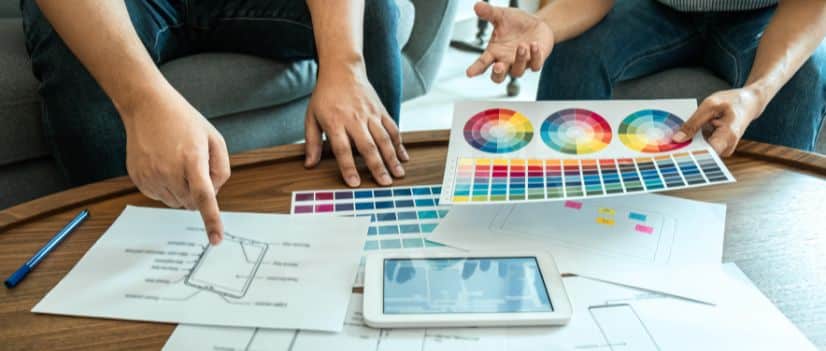Leveraging the Psychology of Colors to Boost Conversions on Your Website in 2024
Introduction:
It’s no secret that colors have a profound impact on human psychology and behavior. In the world of web design, understanding and harnessing the psychology of colors can be a game-changer for your online presence in 2024, drastically improving user engagement, perception, and conversion rates. By incorporating strategic color choices in your website’s design, you can evoke specific emotions, stimulate desired actions, and convey a strong brand message. In this article, we’ll explore the color psychology, reveal how it influences user behavior, and guide you on utilizing color effectively to optimize your website for conversions.
Colors communicate nonverbal messages, making them a powerful design element that can evoke feelings, create associations, and influence users’ decisions. Research has demonstrated that up to 90% of snap judgments about a product or brand can be based on color alone. Therefore, it’s essential to carefully select colors that align with your brand’s core values, audience preferences, and desired outcomes.
Different colors evoke various emotions and associations – impacting website visitors’ perception of your brand and their actions. By tapping into the psychological effects of these colors, you can create a tailored browsing experience that engages users, encourages them to interact with your website, and ultimately drives more conversions.
Understanding the Emotional Impact of Colors Psychology
The primary step in leveraging color psychology is to comprehend how various colors evoke specific emotions and associations. Here’s a quick overview of the most commonly used color psychology effects:
- Red: Symbolizes power, passion, and urgency. Red can grab users’ attention quickly, making it an excellent choice for essential elements like call-to-action buttons. However, overuse of red can create a sense of aggression, so use it strategically.
- Blue: Represents trust, stability, and reliability. Blue is a popular choice for businesses seeking to convey professionalism and credibility. It’s a practical choice for headlines, links, and contrast elements on your website.
- Green: Associated with nature, growth, and health. Green evokes feelings of tranquility and stimulates relaxation, making it perfect for wellness-centered brands. It is also known to indicate positive actions, such as affirming messages and clickable elements.
- Yellow: Symbolizes optimism, energy, and happiness. Yellow can be an excellent accent color to draw attention to specific elements, but its excessive use can generate feelings of anxiety or strain on the eyes.
Boosting Conversions with Strategic Color Combinations
Now that you have a deeper understanding of the emotional impact of colors, it’s crucial to apply this knowledge strategically to enhance user experience and drive conversions. Here are some tips on using color combinations effectively:
- Contrast: Use contrasting colors, like black on white or dark blue on light gray, to maximize the readability and accessibility of your content. Contrast can not only draw attention to essential elements such as headlines and CTAs but also improve overall user experience.
- Color Harmony: Harmonious color schemes create a visually appealing and cohesive design. Employ complementary, analogous, or triadic color schemes to ensure a well-balanced and aesthetically pleasing website that keeps visitors engaged.
- Call-to-Action Colors: Use emotion-provoking colors wisely for your call-to-action (CTA) buttons. Consider users’ emotional response to different colors, and choose a CTA color that drives desired actions while maintaining a sense of urgency.
Adapting to Cultural Color Preferences and Audience Sensitivities
Different cultures have unique perceptions and associations regarding colors. When designing your website with a global audience in mind, it’s important to be aware of these divergent perspectives. Research your target audience’s cultural sensibilities and consider incorporating colors that resonate positively with them while avoiding color combinations that carry negative connotations.
Enhancing Web Accessibility through Color Psychology Choices
The importance of creating a user-friendly website accessible for everyone, including those with vision impairments or color blindness, cannot be overstated. To ensure your website is accessible for all users, consider the following guidelines:
- Color Contrast: Adhere to the Web Content Accessibility Guidelines (WCAG) by maintaining a proper contrast ratio between your text and background colors.
- Clear Signifiers: Avoid relying solely on color to communicate essential information or guide users through actions. Use additional indicators, like text labels, underlined links, or typography to convey meaning.
- Color Blindness Considerations: Aim to create an inclusive design for colorblind users by choosing easily distinguishable colors, like blue/orange or purple/green.
Unleashing the Power of Color Psychology to Drive Conversions
Implementing color psychology in your web design can be a powerful tool in shaping user behavior, enhancing brand perception, and maximizing conversions. By understanding the emotional impact of colors, creating strategic color combinations, adapting to cultural preferences, and prioritising web accessibility, you can create an engaging and inclusive browsing experience that resonates with your target audience and drives measurable results.
As experts in web design and digital marketing, we take pride in helping businesses like yours harness the power of color psychology to elevate your online presence and achieve your conversion goals. Contact Once Interactive today to discover how we can create a visually stunning and impactful website tailored to your unique needs and objectives.






